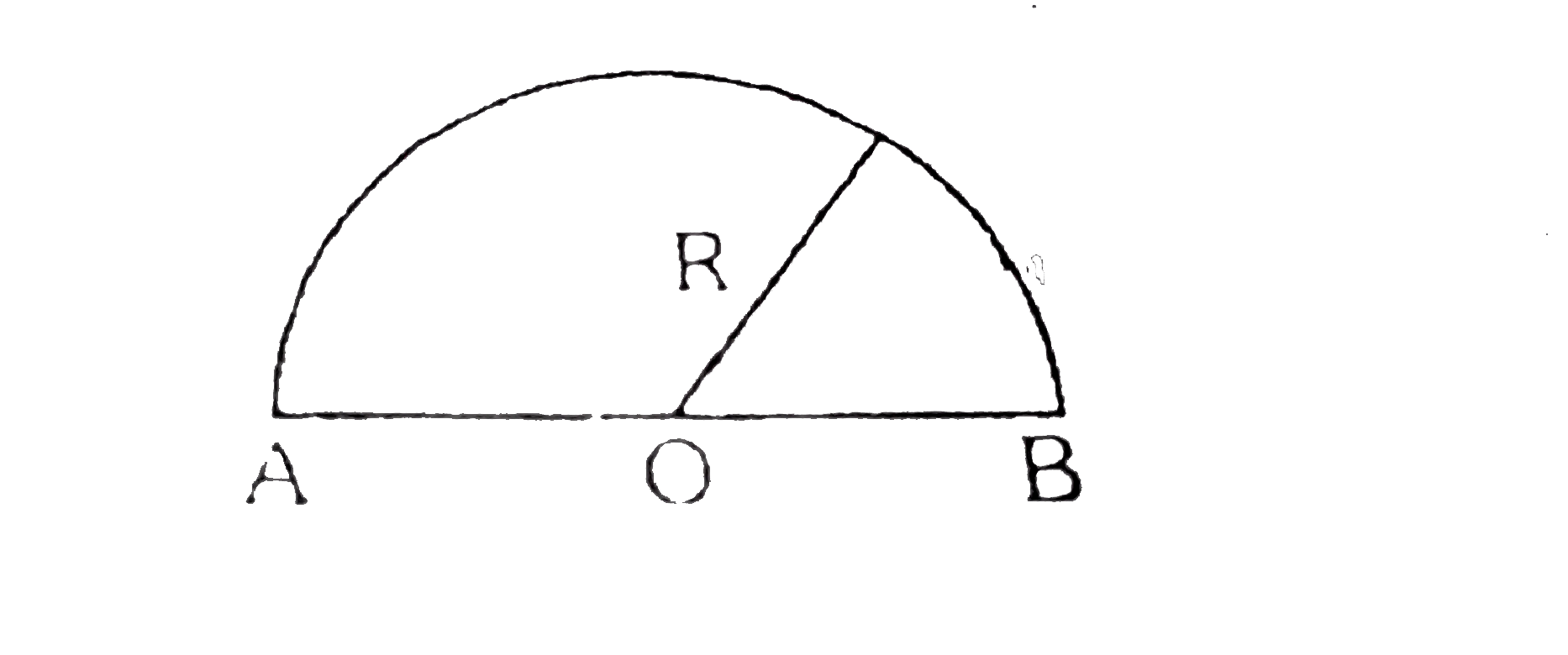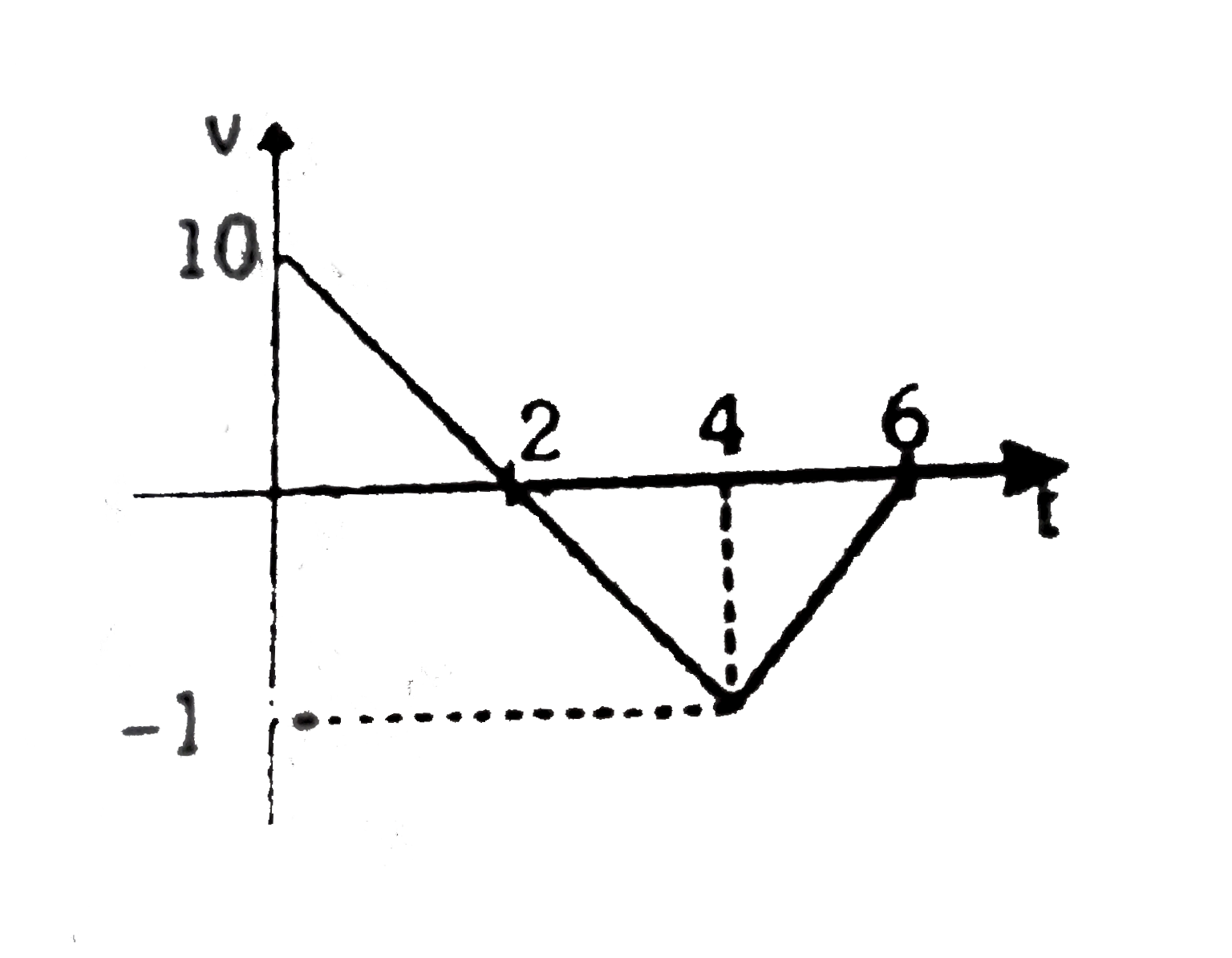A particle is rotating in a circle of radius 1m with constant speed 4m/s. In time 1s, match the following (in SI units)
Column IColumn II(A)Displacement(p)8sin2(B)Distance(q)4(C)Average velocity(r)2sin2(D)Average acceleration(s)4sin2Solution in Gujrati
The correct Answer is:(A)-r, (B)-q, (C)-r (D)-p
Rθ=vt,θ=4×11=4 radius

∴ Displacement =2Rsinθ/2=2sin2
Distance =vt=4m
Average velocity =Displacementtime=2sin2
Average acceleration =Change in velocitytime
=2×4sin21=8sin2
Topper's Solved these Questions
- KINEMATICSBOOK - ALLEN CHAPTER - KINEMATICSEXERCISE - Assertion-Reason
20 Videos
- KINEMATICSBOOK - ALLEN CHAPTER - KINEMATICSEXERCISE - Comprehension#1
3 Videos
- KINEMATICSBOOK - ALLEN CHAPTER - KINEMATICSEXERCISE - EXERCISE-02
57 Videos
- ERROR AND MEASUREMENTBOOK - ALLEN CHAPTER - ERROR AND MEASUREMENTEXERCISE - Part-2(Exercise-2)(B)
22 Videos
- KINEMATICS (MOTION ALONG A STRAIGHT LINE AND MOTION IN A PLANE)BOOK - ALLEN CHAPTER - KINEMATICS (MOTION ALONG A STRAIGHT LINE AND MOTION IN A PLANE)EXERCISE - BEGINNER S BOX-7
8 Videos
Similar Questions
Assertion: A projectile is thrown with an initial velocity of (aˆi+bˆj)m/sec. If range of projectile is maximum then a=b.
Reason: In projectile motion, angle of projection is equal to 45∘ for maximum rang econdition.
View SolutionDistance is a scalar quantity. Displacement is a vector quqntity. The magnitude of displacement is always less than or equal to distance. For a moving body displacement can be zero but distance cannot be zero. Same concept is applicable regarding velocity and speed. Acceleration is the rate of change of velocity. If acceleration is constant, then equations of kinematics are applicable for one dimensional motion under the gravity in which air resistance is considered, then the value of acceleration depends on the density of medium. Each motion is measured with respect of frame of reference. Relative velocity may be greater/ smaller to the individual velocities.
A particle moves from A to B. Then the ratio of distance to displacement is :-

View SolutionA particle is moving in a plane with velocity given by →u=u0ˆi+(aωcosωt)ˆj, where ˆi and ˆj are unit vectors along x and y axes respectively. If particle is at the origin at t=0. Calculate the trajectory of the particle :-
View SolutionA cube has a side of length 1.2×10−2m. Calculate its volume.
View SolutionA football player kicks a ball at an angle of 30∘ with an initial speed of 20 m/s. Assuming that the ball travels in a vertical plane, calculate (a) the time at which the ball reaches the highest point (b) the maximum height reached (c) the horizontal range of the ball (d) the time for which the ball is in the air, (g=10m/s2)
View SolutionA particle starting from rest has a constant acceleration of 4m/s2 for 4 s. It then retards uniformly for next 8 s and comes to rest. Find during the motion of particle (a) average acceleration (b) average speed and (c) average velocity.
View SolutionFor the velocity -time graph shown in figure, in a time interval from t=0 to t=6s, match the following:

Column IColumn II(A)Change in velocity(p)−5/3SIunit(B)Average acceleration(q)−20SIunit(C)Total displacement(r)−10SIunit(D)Acceleration ay t=3s(s)−5SIunit
View SolutionA particle is rotating in a circle of radius 1m with constant speed 4 m//s . In time 1s, match the following (in SI units) {:(,"Column I",,,"Column II"),((A),"Displacement",,(p),8 sin 2),((B),"Distance",,(q),4),((C),"Average velocity",,(r),2sin 2),((D),"Average acceleration",,(s),4 sin 2):}
View SolutionA balloon rises up with constant net acceleration of 10 m//s^(2) . After 2 s a particle drops from the balloon. After further 2 s match the following : ("Take" g=10 m//s^(2)) {:(,"Column I",,,"Column II"),((A),"Height of perticle from ground",,(p),"Zero"),((B),"Speed of particle",,(q),10 SI "units"),((C),"Displacement of Particle",,(r),40 SI "units"),((D),"Acceleration of particle",,(s),20 SI "units"):}
View SolutionA particle is rotating in a cirlce of radius 1 m with constant speed 4 m/s. In time 1s, match the following (in SI unit) {:(,"Table-1",,"Table-2"),("(A)","Displacement","(P)","8 sin 2"),("(B)","Distance","(Q)",4),("(C)","Average velocity","(R)","2 sin 2"),("(D)","Average acceleration","(S)","4 sin 2"):}
View SolutionThis section contains 2 questions. Each question contains statement given in two columns which have to be matched. Statements (a, b, c and d) in Column-I have to be matched with statement (p, q, r and s) in Column-II. The answers to these questions have to be appropriately bubbled as illustrated in the following examples: If the correct matches are (a-p, s), (c-p, q) and (d-s), then correct bubbled 4 xx 4 matrix should be as follows: Match the Column-I with Column -II
View SolutionThis section contains 2 questions. Each question contains statement given in two columns which have to be matched. Statements (a, b, c and d) in Column-I have to be matched with statement (p, q, r and s) in Column-II. The answers to these questions have to be appropriately bubbled as illustrated in the following examples: If the correct matches are (a-p, s), (c-p, q) and (d-s), then correct bubbled 4 xx 4 matrix should be as follows: Match the Column -I with Column -II
View SolutionIn the diagram shown in figure, match the following columns (take g=10 ms^(-2) ) {:("Column I","Column II"),("(A) Normal reaction","(p) 12 SI unit"),("(B) Force of friction","(q) 20 SI unit"),("(C) Acceleration of block","(r) zero"),(,"(s) 2 SI unit"):}
View SolutionThis section contains 3 questions. Each question contains statement given in two columns which have to be matched. Statement (a, b, c and d) in Column-I have to be matched with statement (p, q, r and s) in Column-II. The answers to these questions have to be appropriately bubbled as illustrated in the following examples :
If the correct matches are (a-p, s), (b-q, r), (c-p, q) and (d-s), then correct bubbled 4×4 matrix should be as follows:

Match the column-I with Column-II :

View SolutionThis section contains 3 questions. Each question contains statement given in two columns which have to be matched. Statement (a, b, c and d) in Column-I have to be matched with statement (p, q, r and s) in Column-II. The answers to these questions have to be appropriately bubbled as illustrated in the following examples : If the correct matches are (a-p, s), (b-q, r), (c-p, q) and (d-s), then correct bubbled 4 xx 4 matrix should be as follows: Match the column-I with Column-II :
View SolutionThis section contains 3 questions. Each question contains statement given in two columns which have to be matched. Statement (a, b, c and d) in Column-I have to be matched with statement (p, q, r and s) in Column-II. The answers to these questions have to be appropriately bubbled as illustrated in the following examples : If the correct matches are (a-p, s), (b-q, r), (c-p, q) and (d-s), then correct bubbled 4 xx 4 matrix should be as follows: Match the column-I with Column-II :
View Solution
